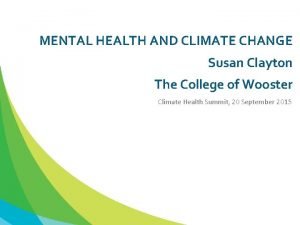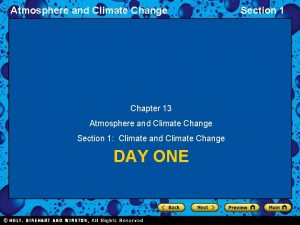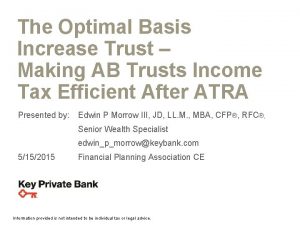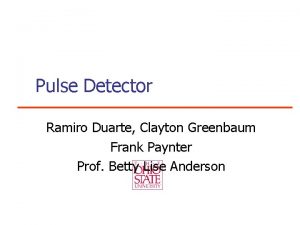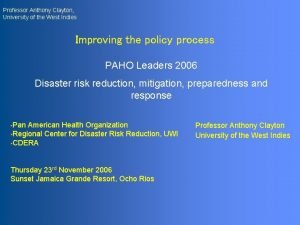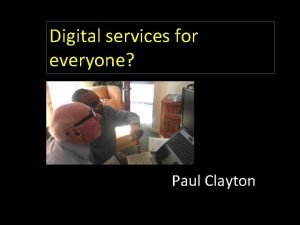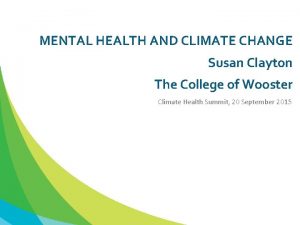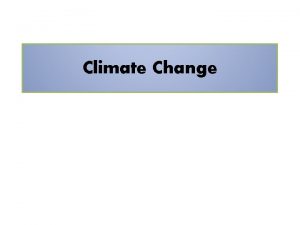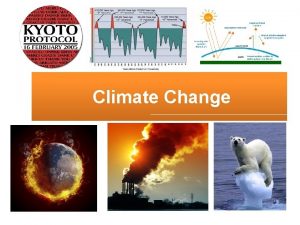MENTAL HEALTH AND CLIMATE CHANGE Susan Clayton The

























- Slides: 25

MENTAL HEALTH AND CLIMATE CHANGE Susan Clayton The College of Wooster Climate Health Summit, 20 September 2015

Why look at the effects of climate change on mental health?

1. Understanding impacts is critical to preparing for them (on a community level) 2. Describing the impacts can improve understanding of climate change 3. Health impacts can personalize the issue and transcend the partisan divide

How could climate change affect mental well-being?

The multi-level impacts of climate change 1. Direct and indirect effects 2. Acute and gradual changes 3. Experience and perception

Source: Eco. America http: //ecoamerica. org/research/#Psych. Impacts

Source: Eco. America http: //ecoamerica. org/research/#Psych. Impacts

Source: Eco. America http: //ecoamerica. org/research/#Psych. Impacts

Direct effects PTSD Depression Domestic abuse General anxiety Suicide and suicidal ideation “Complicated grief” Substance abuse -- may last several years or longer 9

E. g. , effects of Hurricane Katrina 49% developed an anxiety or mood disorder 1 in 6 developed posttraumatic stress disorder 10

Indirect effects Due to economic difficulties, Damage to physical and social infrastructure, Environmental degradation, All possibly requiring migration 11

Indirect effects Natural disasters in 2014 cost $25 billion in the US (this includes earthquakes) and $110 billion worldwide Natural disasters in 2014 displaced 19 million people worldwise 12

Broad implications Diminished sense of self loss of place and disruption of place bonds loss of occupation loss of lifestyle and culture Lowered autonomy Reduced social cohesion weakened social ties increased conflict 13

Uncertainty about climate change Individual responses lack of control, anxiety about unpredictability Intergroup tensions over meaning due to perceived inequity 14

Effects of anxiety about the future Stress Hopelessness 15

Who will be affected?

Not everyone will be affected equally • At greater risk: • Women, children, members of marginalized communities • Those already suffering from mental illness

HOW are children vulnerable? Physical vulnerability: Immaturity can enhance the risk of disease, impact of persistent stress, and effects of malnutrition. Stress itself, along with malnutrition and lack of clean water, makes the body more vulnerable. 18

HOW are children vulnerable? Social vulnerability: Disruption to education Psychological vulnerability: Dependence on others Need for security Effects will depend on the child’s developmental stage as well as sources of resilience. 19

What can be done? Promoting resilience

Factors associated with resilience Practical support Community ties Sense of optimism

• Plan ahead • Establish the infrastructure to encourage adaptation • Strengthen social networks • Provide resources to cope with disasters, including informational resources and mental health support • Educate • Encourage optimism and sense of efficacy 22

Mental health is not just the absence of mental disorder! Climate change presents an opportunity • to examine the social and physical infrastructure of our communities • to consider opportunities of enhancing wellbeing 23

More You Can Do 1. Communicate about the health effects of climate change 2. Get involved in disaster preparedness efforts 3. Health practitioners: do more research, and incorporate into practices 4. Coordinate and support with others involved in addressing climate change

Thank you! Questions?
 Climate change 2014 mitigation of climate change
Climate change 2014 mitigation of climate change Susan clayton wooster
Susan clayton wooster Mental health and mental illness chapter 20
Mental health and mental illness chapter 20 Mental health jeopardy questions
Mental health jeopardy questions How is climate change affecting health
How is climate change affecting health Profiling serial killers
Profiling serial killers Russell odom and clay lawson
Russell odom and clay lawson Climate change meaning and definition
Climate change meaning and definition Chapter 13 atmosphere and climate change section 1
Chapter 13 atmosphere and climate change section 1 Chapter 13 atmosphere and climate change
Chapter 13 atmosphere and climate change Gcche
Gcche Clayton townley
Clayton townley Clayton greenberg
Clayton greenberg Clayton atreus
Clayton atreus Atlanta rm clayton water reclamation plant
Atlanta rm clayton water reclamation plant Bypass trust diagram
Bypass trust diagram Clayton greenbaum
Clayton greenbaum John patrick clayton
John patrick clayton Clayton antitrust act def
Clayton antitrust act def Lockheed martin information systems & global solutions
Lockheed martin information systems & global solutions Clayton fopp
Clayton fopp Professor anthony clayton
Professor anthony clayton Clayton alderfer
Clayton alderfer Paul clayton facebook
Paul clayton facebook Roe vs wade dissenting opinion
Roe vs wade dissenting opinion Clayton koobs
Clayton koobs

